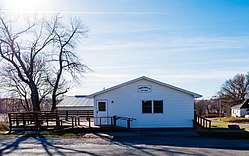Yorktown, Iowa
Yorktown is a city in Page County, Iowa, United States. The population was 85 at the 2010 census.
Yorktown, Iowa | |
|---|---|
 | |
 Location of Yorktown, Iowa | |
| Coordinates: 40°44′2″N 95°9′17″W | |
| Country | |
| State | |
| County | Page |
| Area | |
| • Total | 0.27 sq mi (0.70 km2) |
| • Land | 0.27 sq mi (0.70 km2) |
| • Water | 0.00 sq mi (0.00 km2) |
| Elevation | 1,089 ft (332 m) |
| Population | |
| • Total | 85 |
| • Estimate (2019)[3] | 86 |
| • Density | 316.18/sq mi (122.07/km2) |
| Time zone | UTC-6 (Central (CST)) |
| • Summer (DST) | UTC-5 (CDT) |
| ZIP code | 51656 |
| Area code(s) | 712 |
| FIPS code | 19-87420 |
| GNIS feature ID | 0463248 |
History
Yorktown was platted in 1882 by C. E. Perkins. It had a station on the Humeston and Shenandoah Railway.[4]
Geography
Yorktown is located at 40°44′02″N 95°09′17″W (40.733779, -95.154798).[5] It lies 1½ hours' driving time from Omaha, 2½ hours from Des Moines, and three hours from Kansas City. The city sits in the rolling hills of southwestern Iowa, about 10 miles (16 km) from the Missouri border.
According to the United States Census Bureau, the city has a total area of 0.27 square miles (0.70 km2), all land.[6]
Demographics
| Year | Pop. | ±% |
|---|---|---|
| 1900 | 170 | — |
| 1910 | 228 | +34.1% |
| 1920 | 193 | −15.4% |
| 1930 | 217 | +12.4% |
| 1940 | 197 | −9.2% |
| 1950 | 146 | −25.9% |
| 1960 | 150 | +2.7% |
| 1970 | 105 | −30.0% |
| 1980 | 123 | +17.1% |
| 1990 | 100 | −18.7% |
| 2000 | 82 | −18.0% |
| 2010 | 85 | +3.7% |
| 2019 | 86 | +1.2% |
| Source:"U.S. Census website". United States Census Bureau. Retrieved 2020-03-29. and Iowa Data Center Source: | ||
2010 census
As of the census[2] of 2010, there were 85 people, 32 households, and 24 families living in the city. The population density was 314.8 inhabitants per square mile (121.5/km2). There were 37 housing units at an average density of 137.0 per square mile (52.9/km2). The racial makeup of the city was 87.1% White, 7.1% African American, 1.2% Native American, and 4.7% from other races. Hispanic or Latino of any race were 1.2% of the population.
There were 32 households of which 25.0% had children under the age of 18 living with them, 62.5% were married couples living together, 6.3% had a female householder with no husband present, 6.3% had a male householder with no wife present, and 25.0% were non-families. 18.8% of all households were made up of individuals and 6.3% had someone living alone who was 65 years of age or older. The average household size was 2.66 and the average family size was 2.96.
The median age in the city was 47.3 years. 24.7% of residents were under the age of 18; 7.1% were between the ages of 18 and 24; 16.5% were from 25 to 44; 31.8% were from 45 to 64; and 20% were 65 years of age or older. The gender makeup of the city was 57.6% male and 42.4% female.
2000 census
As of the census[8] of 2000, there were 82 people, 36 households, and 25 families living in the city. The population density was 297.2 people per square mile (113.1/km2). There were 41 housing units at an average density of 148.6 per square mile (56.5/km2). The racial makeup of the city was 100.00% White.
There were 36 households out of which 30.6% had children under the age of 18 living with them, 58.3% were married couples living together, 8.3% had a female householder with no husband present, and 27.8% were non-families. 25.0% of all households were made up of individuals and 19.4% had someone living alone who was 65 years of age or older. The average household size was 2.28 and the average family size was 2.65.
20.7% are under the age of 18, 8.5% from 18 to 24, 30.5% from 25 to 44, 20.7% from 45 to 64, and 19.5% who were 65 years of age or older. The median age was 40 years. For every 100 females, there were 90.7 males. For every 100 females age 18 and over, there were 97.0 males.
The median income for a household in the city was $30,417, and the median income for a family was $38,125. Males had a median income of $29,583 versus $27,188 for females. The per capita income for the city was $13,248. There were 17.6% of families and 23.2% of the population living below the poverty line, including 36.4% of under eighteens and 22.7% of those over 64.
Education
The Clarinda Community School District serves the municipality.[9]
References
- "2019 U.S. Gazetteer Files". United States Census Bureau. Retrieved July 17, 2020.
- "U.S. Census website". United States Census Bureau. Retrieved 2012-05-11.
- "Population and Housing Unit Estimates". United States Census Bureau. May 24, 2020. Retrieved May 27, 2020.
- Kershaw, W. L. (1909). History of Page County, Iowa. S.J. Clarke Publishing Company. p. 372.
- "US Gazetteer files: 2010, 2000, and 1990". United States Census Bureau. 2011-02-12. Retrieved 2011-04-23.
- "US Gazetteer files 2010". United States Census Bureau. Archived from the original on February 20, 2011. Retrieved 2012-05-11.
- "Census of Population and Housing". Census.gov. Retrieved June 4, 2015.
- "U.S. Census website". United States Census Bureau. Retrieved 2008-01-31.
- "Clarinda." Iowa Department of Education. Retrieved on July 20, 2018.